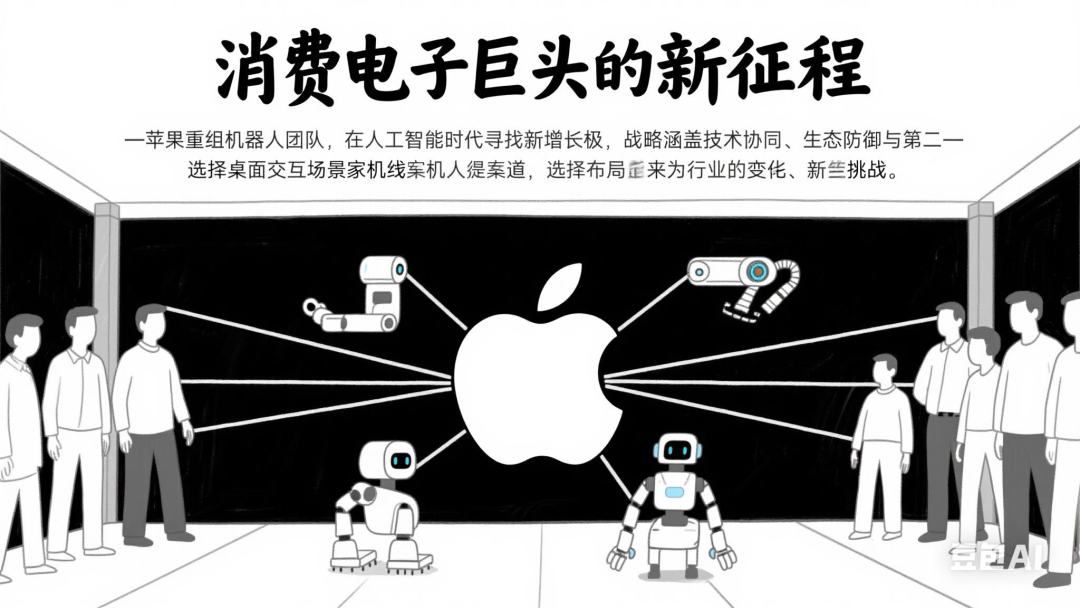
In the context of artificial intelligence reshaping the industrial landscape, Apple’s recent strategic reorganization of its robotics team clearly demonstrates the urgent need for transformation as the consumer electronics giant explores new growth curves. Combining Apple’s ecosystem layout with industry development trends, the following are the core insights: 1. The Three-Dimensional Driving Logic of Apple’s Robotics Strategy 1.1. Technology Integration Loop: Integrating the robotics business into the hardware department aims to streamline the R&D chain of AI algorithms, mechanical design, and sensor fusion. Leveraging the heterogeneous computing power accumulated from the M-series chips and spatial computing devices, it provides edge intelligence support for home robots, achieving full-chain collaboration from data processing to physical execution. 1.2. Ecosystem Defense Upgrade: In the battle for smart home entry points, robots, as physical interaction terminals, can fill the coverage gap of the “last three meters” in the HomeKit ecosystem. Desktop robots equipped with Apple Intelligence essentially serve as a physical extension of Siri, enhancing user engagement through physical space interaction. 1.3. Second Growth Engine: With the iPhone market penetration reaching a bottleneck, Apple urgently needs to cultivate new categories with shipments in the millions. Referencing the commercialization path of the Apple Watch, home robots are expected to open new revenue growth points through a gradual iteration of “high-end feature phones → smart hubs → service platforms.” 2. Opportunity Deconstruction in the Home Robotics Sector 2.1. Market Segmentation and Differentiated Positioning: The North American market has formed segmented tracks such as cleaning (e.g., iRobot), security (e.g., Ring), and companionship (e.g., Astro). Apple’s choice to enter the desktop interaction scene effectively avoids red ocean competition, focusing on the intelligent interaction gap in home scenarios. 2.2. Technological Breakthroughs and Cost Optimization: Advances in multimodal large models have made natural interaction a reality, while the reduction in SLAM algorithm costs has promoted the popularization of home navigation functions. Apple’s UWB chip ecosystem and visual algorithm accumulation create significant technological barriers. 2.3. Pricing Strategy and Profit Model Innovation: Compared to Tesla’s Optimus priced at $20,000, Apple’s $1,000 desktop robot aligns better with consumer electronics price expectations and is likely to replicate the HomePod’s “hardware + subscription service” profit model. 3. Competitive Strategies of Domestic Manufacturers 3.1. Technical Route Choices: Companies like Huawei and Xiaomi are positioning humanoid robots to seize the “general platform” opportunity but must be cautious of falling into high-cost R&D dilemmas; manufacturers like OPPO and vivo focus on vertical scenarios and can learn from Ecovacs’ incremental innovation path in the cleaning robot sector. 3.2. Ecosystem Differentiation Construction: The Android camp should leverage the advantages of open systems to build a “large model + sensor + actuator” modular platform, avoiding direct competition with Apple’s closed ecosystem and achieving breakthroughs through scenario-based customization. 3.3. Supply Chain Advantage Transformation: Relying on the mature supply chains of core components like servo motors (e.g., Baku) and LiDAR (e.g., SUTENG), domestic manufacturers need to accelerate the independent R&D of key technologies such as bionic joints and tactile sensors to break through technical bottlenecks. 4. Industry Development Trend Outlook 4.1. Key Window Period and Standard Competition: From 2025 to 2027, as 10G broadband becomes widespread and edge AI computing power increases, home robots will undergo a three-stage evolution from “tool-type → interaction-type → cognitive-type.” If Apple can launch products as scheduled in 2026, it may redefine industry standards. 4.2. Emotional Computing Technology Competition: Apple’s “ELEGNT” framework indicates that emotional resonance capabilities will become the next competitive focus. Domestic manufacturers need to establish technological advantages in emotional recognition (e.g., micro-expression analysis) and personalized interaction (e.g., digital avatars). 4.3. Regulatory Risks and Compliance Layout: Home scenarios involve sensitive issues such as privacy protection and data sovereignty, and the EU AI Act’s special regulatory requirements for emotional interaction robots compel manufacturers to build compliance systems in advance to address potential risks. In the industrial transformation from smartphones to spatial computing devices, home robots are becoming the “fourth screen” that tech giants are competing for. Apple’s entry will accelerate the industry’s leap from technological validation to commercialization, but the ultimate market winners will need to find the best balance between the depth of technological innovation, the breadth of ecosystem integration, and the warmth of humanistic care. For domestic manufacturers, rather than blindly following international giants, it is better to deeply cultivate unique application scenarios in Chinese households—such as the companionship needs of three generations living together and the kitchen intelligent transformation brought by the popularity of pre-prepared meals—establishing competitive advantages in niche markets through localized innovation. The ultimate competition in the robotics industry is not only a contest of technological strength but also a battle for a deep understanding of the essence of human life.